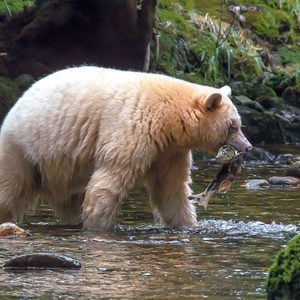Meet the Woman Who’s Saving Asia’s Elephants
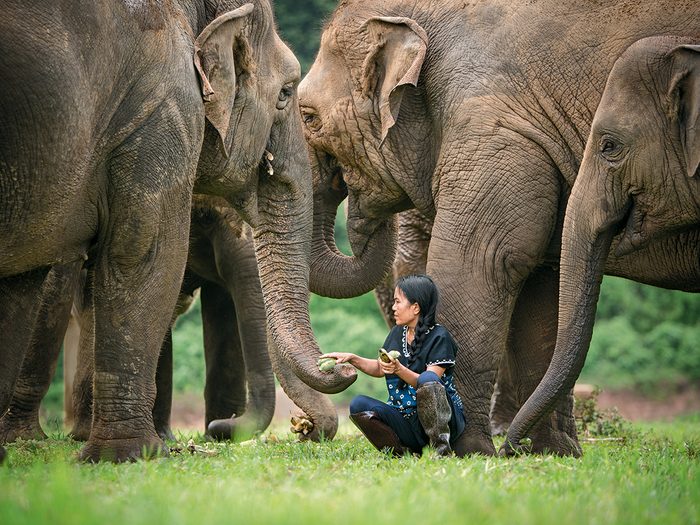
Lek Chailert started with a humble goal: rescue one abused bull. Now, she's the head of an international non-profit with a mission to end the mistreatment of elephants.
In the mountainous jungles of northern Thailand, I am being assaulted by a baby elephant. Her trunk has searched my pocket, and, finding nothing of worth, is now bent on stealing the camera hanging around my neck. If this two-year-old were any larger, the mugging would likely succeed, but Pyi Mai is only one metre tall and 230 kilograms. I’ve met larger ponies. Her delinquent trunk does, however, manage to coat my lens with elephant slobber.
I am at Elephant Nature Park (ENP), a sanctuary that is home to 118 elephants, ranging from the adorable to the heartbreaking. ENP has rescued the adults from appalling situations: Some are crippled, some blind; almost all are traumatized. They are now, unquestionably, happier than they have ever been.
In the city of Chiang Mai, 100 kilometres south of ENP, is blessed with exquisite temples and sees as many as seven million tourists a year. ENP is an easy day trip for those who wish to experience living, trumpeting versions of the creatures they’ve seen carved into the ancient architecture here.
Chiang Mai has also become a favourite hub for digital nomads, which was my prime reason for visiting: to see whether it might be a good place to spend a few years writing my next novel. I thought I might check out co-working spaces and cafes. I did not imagine I would be converted into an apostle for an elephant sanctuary.
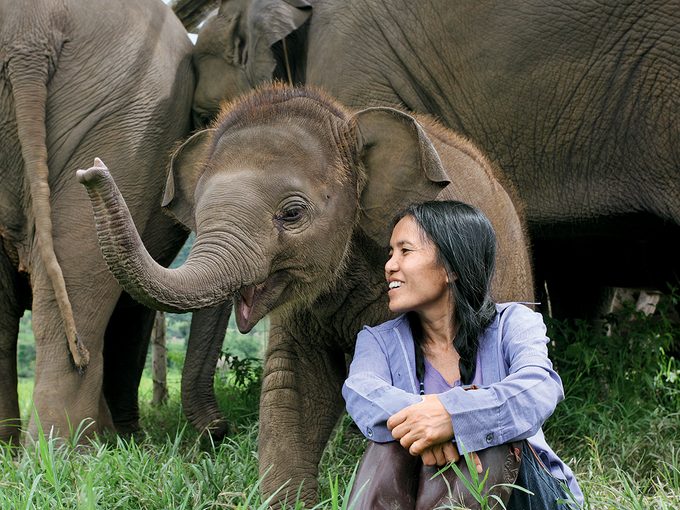
The woman at the heart of a movement
This institution and its many satellites are the life’s work of Saengduean “Lek” Chailert. Her tireless efforts to improve the lot of Asian elephants turned her into an international celebrity more than two decades ago, despite her humble beginnings; she is from a hill tribe, and was at that time the only female from her village ever to attend school. Chailert was named a Ford Foundation “Hero of the Planet” in 2001. Time magazine declared her a “Hero of Asia” in 2005. And in 2010, then U.S. Secretary of State Hillary Clinton designated her one of six “Woman Heroes of Global Conservation.”
Today, her international non-profit Save Elephant Foundation (SEF) is even more influential. It’s been directly involved in the rescue and rehabilitation of about 200 elephants. During the pandemic it supported nearly 10 times that many across Thailand—helping feed them, offering medical services and improving their living conditions.
Chailert, 61, is known to everyone by her nickname, Lek, which means “tiny” in Thai slang; she is about five feet tall. She has devoted her life to the plight of the Asian elephant, the world’s second-largest land animal. The only one larger is another pachyderm, the African savannah elephant, which belongs to a separate genus. The Asian elephant has smaller ears, its head is topped with two prominent domes, and its trunk has only one prehensile fingerlike extension, instead of two. They are equally magnificent.
Lek is a humble, soft-spoken woman, with angular features and oversized glasses. In English, which of course isn’t her first language, she tells me that her work to save Thailand’s national animal started when she was 16 and in secondary school. An encounter with elephants in the logging industry changed her life.
“When I went to see the elephants work very hard in the jungle, I saw one bull get abused, beaten badly. Every time he pulled a giant log, he is screaming. And when he look at me, the eyes, that screaming noise…” she points to her temple. “It is diffcult to get that out.”
She decided to help him, and returned to the logging site with medicine for the bull’s infections. “I asked the owner, ‘Why the old elephant still work? Why the blind elephant still forced to work? When they will go to rest?’ And the owner said, ‘When they die.’”
Lek’s initial goal was modest: to rescue only that bull elephant. She wanted to bring him to her home and release him, “to let him play with the mud bath, give him his final time with freedom, dignity.” She eventually saved enough money to buy him, but when she returned to the logging site she learned that he had died. Her goal changed: to save all the mistreated elephants in Asia.
“And I decided to create our place, not just to rescue elephants, but to educate people, raise awareness, bring more voice.”
“Bringing more voice” is critical. The United Nations’ Food and Agriculture Organization estimates that Thailand had roughly 200,000 Asian elephants at the beginning of the 20th century, half of them domesticated, half of them wild. Today—mostly due to humans destroying their habitat—perhaps 3,800 captive elephants remain, and most experts estimate some 3,000 roam free.
Working elephants were integral to the country’s teak logging, but when that industry was banned in 1989, their owners looked for a new use for them. They often penned the elephants in camps where tourists could pet and ride them, as well as watch them ride tricycles, manipulate hula hoops and throw basketballs.
Few tourists realize that to make an elephant docile enough to do tricks, you have to break the animal mentally. Called phajaan in Thai, this involves beatings with sharp objects like the bullhook (a steel staff with a hooked end). Torture, essentially.
When the pandemic hit, tourism ground to a halt and owners found themselves with giant creatures they couldn’t afford to feed. Many elephants starved to death. Pyi Mai and another baby, Chaba—her best friend—were captive at a camp where tourists could ride older elephants, and where the animals put on shows including bike-riding. It also had a breeding program, and the mothers were so emaciated they could barely produce milk.
Their owners would certainly not have entrusted them to ENP before the pandemic. Most people in the elephant business have resented Lek’s advocacy; she had drawn international attention to its cruel practices. During the lockdown, however, ENP established a food bank. At one point it was feeding almost 2,000 elephants, more than half of Thailand’s captive population.
The crisis offered an unexpected opportunity: Lek and her people were now aiding businesses that had long considered ENP the enemy. It was a window for diplomacy, and—with gentle prodding—attitudes began to change in the camps.
The two baby elephants and their mothers were at last freed to join ENP, where they have established a small herd. Unrelated female elephants often babysit and develop strong bonds with another elephant’s calf; Pyi Mai and Chaba now have their own pachyderm nanny, D-Max.
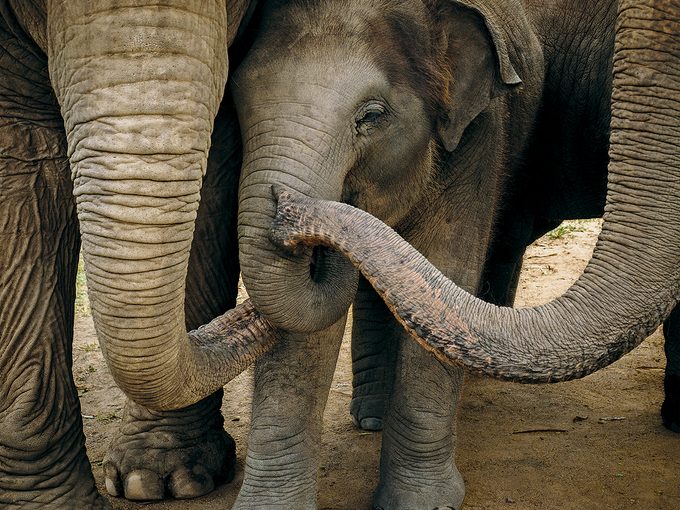
Inside the Chiang Mai elephant sanctuary
They also have room to wander, which is essential to an elephant’s health. The 81-hectare sanctuary concentrates on rescuing injured and abused creatures that could never survive in the wild. They have wounds that won’t heal, problems with mobility, incapacitating psychological issues. The aim is to treat their ailments and provide them with a life that’s as close as possible to what they would have experienced had it not been for humans.
Within the Chiang Mai elephant sanctuary, a slow, wide river divides an impossibly green jungle, and in the less wild areas you find odd impositions upon nature: a miniature Stonehenge, for instance, which turns out to be a monolithic backscratching station. The elephants like to rub up against the rough stones as they consume astonishing quantities of watermelons, bananas and sugarcane during scheduled lunches. Other items rarely found in the wild are a massive scale for weighing elephants, and a giant artificial hydrotherapy pool where disabled elephants can work on movement. The weightlessness they experience in the pool is a relief for legs accustomed to supporting several tons.
Tourists are not allowed to touch the creatures (Pyi Mai chose to make contact with me), but there’s often no barrier between humans and elephants. Even the volunteers have only minimal contact; necessary hands-on work is restricted to staff and medical personnel. For a time ENP allowed humans to bathe the animals, but elephants really don’t require bath attendants; they just trundle into the river. The point is to let them be elephants.
A captive elephant in Thailand typically experiences torture and humiliation, gruelling labour and separation from its family. Their complex psychology and social behaviour are callously disregarded. It used to be common, for instance, to take baby elephants into the city as props to aid in begging. Many of these elephants would never see their mothers again. Yet in the wild, a baby is never far from its mother, and a female stays with the matriarchal herd for life.
Lek Chailert is changing this, despite some venomous opposition—including online harassment and even death threats—from people wedded to the old barbaric ways. Her influence has spread across Thailand, and is reaching into Cambodia, Laos, Sri Lanka, Vietnam and Myanmar.
I meet a Nepalese family here who have been running an elephant safari in Nepal; a former volunteer from ENP told them about Lek’s revolution, and they want to convert their operation to an ethical sanctuary. They’ve come here to see these principles in action.
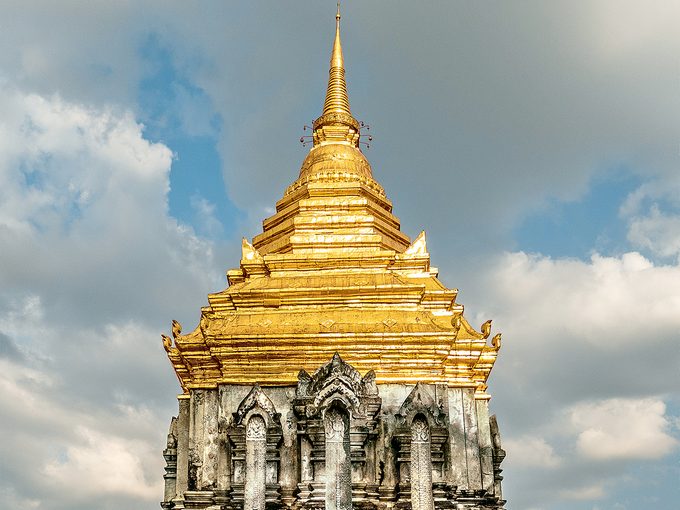
Passionate volunteers
ENP is not restricted to pachyderms alone. The team also cares for 100 water buffalo, 150 wild boars, 130 cows, 30 goats, a “kingdom of cats”—approximately 2,000 of them—and 650 dogs, 50 of them disabled, many rescued from Bangkok during severe floods in 2011.
The sanctuary has three veterinarians who specialize in elephants, six general vets and a posse of veterinary nurses. They’re experimenting with elephant prosthetics and other devices: I’m shown a fibreglass contraption that they hope will stabilize an injured knee. ENP is working on a fully equipped elephant hospital and plans to complete it in 2024.
The volunteers I encounter—from Australia, the United States and the United Kingdom—are impressively cheerful, and range from their teens to their 90s. Everyone dines communally in a rustic open pavilion, and I join them for lunch, an outdoor buffet featuring Thai vegan cuisine of the highest order. They tend to have rapturous stories about a near-religious conversion, about how an encounter with Lek and her organization caused them to reorient their lives towards an unexpected goal: elephant rescue.
I meet Lee and Roger Denison from Wokingham, U.K., who first visited ENP in 2018 just after Roger retired at age 60. This is their third time volunteering; they’ll be here for two weeks. Much of the work while I’m here involves cleaning the banks of the river in the wake of the worst flooding in at least 20 years. But the tasks are numerous and diverse: preparing food for various species and presenting it to them, mucking out stables, helping build roads.
Between work sessions, volunteers relax with the elephants. “It’s going to be part of our holiday vacation every single year now,” says Lee Denison. “We’ve even made provisions in our will for ENP.”
Kathy Snyder is a volunteer from Redding, California; this is her fifth time at the sanctuary, and she’ll be staying for a month. “When I first came here, Lek said, ‘I hear you’re a nurse. I have a sick elephant that needs medical care. Can you help me out?’” That was six years ago. Since then, caring for elephants has been one of Snyder’s chief joys in life.
Snyder, who has volunteered at several other sanctuaries around the world, stresses that she’s a “human nurse” but that the skills are transferable; wound care, for example. Moreover, she says, most mammals “have the same bones and organs; they’re just bigger or smaller or in a different spot.”
In 2018, Snyder helped with laser treatments for an elephant named Dalah. Before she was rescued, Dalah’s legs had been badly wounded during a forced breeding session and she had also suffered organ damage. Forced breeding sometimes involves chaining a female by all four feet. The male elephant, typically between the ages of 10 and 15 and experiencing a spike in testosterone that increases their volatility and aggression, is jabbed with a bullhook until he mounts the female.
Despite what the team accomplished for Dalah’s legs, she did not survive her internal injuries. The hydrotherapy pool is named in her memory.
“I make it a point to come here as often as I can,” says Snyder. “It gets in your heart. You can’t stay away.”
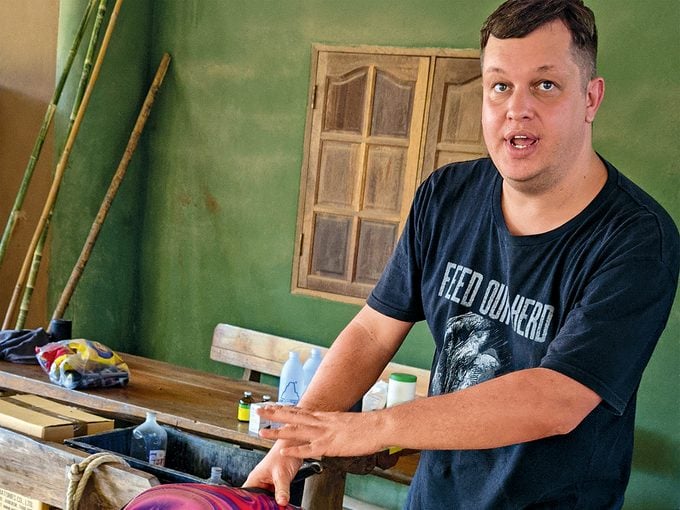
Agents of Change
During my visit, I’m squired around by the foundation’s project director, Ry Emmerson, a cherubic ex-cop from northern England (whose pronunciation of “elephant” is “elly-phant”). Now 35, he was once a corrections officer at a high-security prison for men, including those convicted of sex offences. “Very challenging and risky people,” he says. “Part of my job was talking with offenders about why they committed their offense in order to better understand how to help them reduce their risk of offending in the future.”
It was good training for his current job, which involves convincing people in the elephant business to change their practices.
How did a British ex-cop end up in the jungle? In 2012, when Emmerson found he was no longer satisfied with his work, he took a career break and began travelling, often volunteering at animal rescue operations in various countries. In Thailand, he experienced ENP with awe. Then, seven years ago Emmerson was hired as project director on an elephant sanctuary that Lek’s organization was building in Myanmar, Thailand’s neighbour to the west.
With the ongoing political turmoil in Myanmar, the sanctuary proved unworkable, and he found himself helping with other projects supported by SEF. “My role now includes a bit of everything,” says Emmerson, the only foreigner working at the office in Chiang Mai. That includes project management, handling international media and coordinating Lek’s schedule. And, crucially, when an elephant organization approaches SEF because it wants to be more ethical, Emmerson is the one who goes in to help them change.
“I have to go places where I see elephants in horrific conditions,” says Emmerson. “In Myanmar, I met with a family whose business was poaching elephants. You have to control yourself as you listen to what they’re telling you. Because if you start to cry when you hear how brutal what they’re doing is, they’re not going to tell you.”
Later I learn that today, most baby elephants are born into captivity as a result of forced breeding. But at one time, trapping elephants often involved slaughtering elderly herd members and trafficking the younger ones to entertain tourists. Even the most hardened cop would likely have a hard time not being reduced to tears by what Emmerson deals with. Just visiting ENP is emotionally complicated. It’s wonderful to get close to these animals, but you’re always aware of why they’re here.
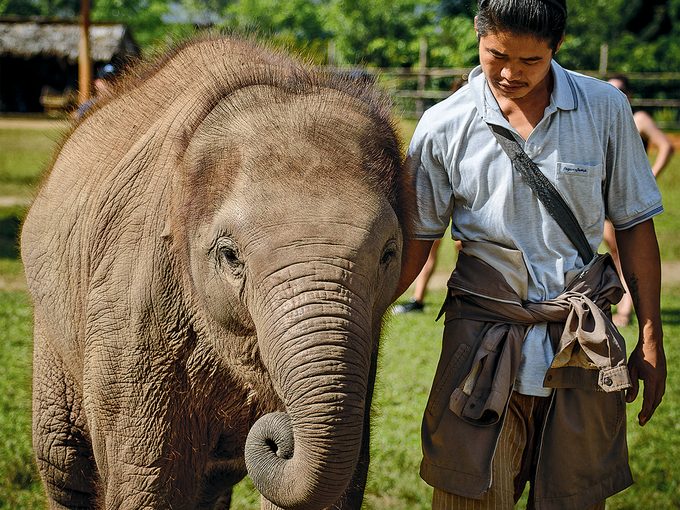
The way forward
Emmerson takes me to meet the baby hellraisers, Pyi Mai and Chaba. “They’re inseparable,” he says. “Everywhere they go they create chaos.” When he greets Pyi Mai, he puts her trunk up to his mouth and blows into it, as if playing a didgeridoo. Apparently, an elephant can tell a lot from your breath. “She wants to know, ‘Where have you been? Which other elephants can I smell?’”
We go for a walk to meet Mae Sri, who’s in her 70s and dotted with bluegreen spots, which are wound treatments. Until she was rescued in 2018, Emmerson tells me, Mae Sri had been abused in the riding industry.
“When she came here she was skin and bones, with many open wounds.” She has arthritis and when she falls, a truck-mounted hydraulic crane must help her up. The sanctuary has built her a special “bed,” a sloping sand bank, so that she doesn’t have to lie down: She simply leans at a 45-degree angle.
Every elephant I encounter is accompanied by a dedicated mahout (elephant handler). When you rescue an elephant, you generally have to rescue their mahout—they come as a unit—or pair the elephant with a new handler. Hence, ENP houses an entire community of mahouts, often refugees from Myanmar or hill tribesmen. The park employs their wives in traditional roles—working in the kitchen, or housekeeping—and gives scholarships to their children.
Mahouts have to be convinced to change habits passed down for generations. “They have been taught that if you don’t chain an elephant, it will kill you; that if you don’t use the hook, it will kill you,” says Emmerson. Bullhooks are routinely used to inflict pain, enforcing behaviour. The hook is jabbed into a sensitive area, often behind the ear.
There’s no question that elephants can be dangerous, especially when tormented. Males, generally far more aggressive than females, can pick up a large rock with their trunk and throw it at you with the accuracy of a talented baseball pitcher. Nevertheless, the most effective way to manage elephants—and the only decent way—is with positive reinforcement: You reward good behaviour rather than punishing bad.
The inhumane elephant camps for tourists have to be taught this approach, and to be shown that, thanks to the growing demand for ethical tourism, there are alternatives to brutality.
ENP is proof tourists will gladly pay for the chance to observe elephants happily being elephantine. But Emmerson is realistic. “Elephant owners in Thailand are not changing overnight because they suddenly love their elephants. It’s about the business model.”
The economics were rendered much more difficult, of course, by the pandemic. ENP relied upon various ingenious programs to generate money in the absence of tourism. It developed a system to foster an elephant from afar, and the option to remotely present an elephant with a birthday “cake” (a whimsical fruit arrangement). It may be your elephant-besotted daughter’s birthday, but it’s the excited elephant who gets the cake; your daughter gets the video. This ritual was so popular that ENP has maintained it.
These programs were devised, however, as stopgaps until the tourists returned, and that remains an uncomfortable paradox: ENP is devoted to saving elephants from exploitation by tourists, but the hard financial truth is that keeping these creatures alive, even in a rigorously ethical sanctuary, requires some form of tourism. It’s not a question of ending elephant tourism, but reinventing it.
My last experience at the Chiang Mai elephant sanctuary is watching a glorious daily ritual late in the afternoon. The elephants swim down the river into camp to spend the evening, led by the precocious 11-year-old Kham La, who has somehow taken charge of companions at least twice her age. An overhead complex of viewing platforms, the SkyWalk, allows visitors to observe the herd climbing onto the banks, trumpeting and rolling in the mud. They’re clearly enjoying life. If tourism is a necessity, then this is how it should be done.
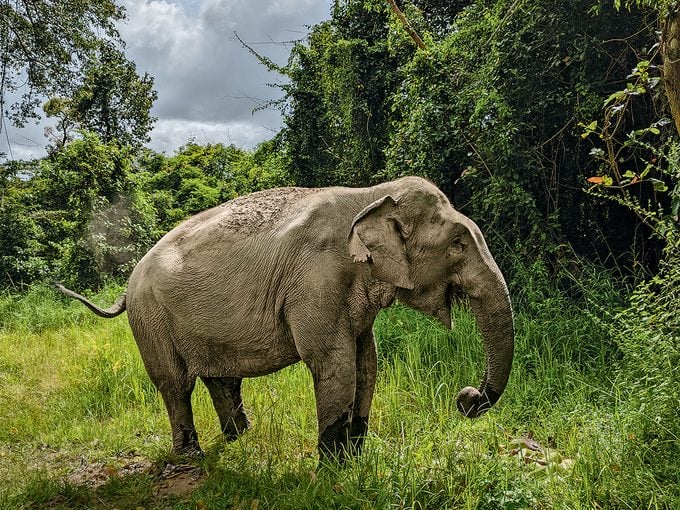
Emmerson is unsurprised by how ENP has affected me. Even after decades of animal activism I don’t have the stomach for stories of abuse, and it shows in my face—as does my admiration for the wondrous things they’re accomplishing here. He suggests I visit their project just outside of Siem Reap in Cambodia. Even before the pandemic, it hadn’t been drawing sufficient visitors and volunteers—despite being less than a two-hour drive from the Angkor Wat temple complex, the nation’s most popular tourist destination.
Cambodia Wildlife Sanctuary sits in a vast swathe of jungle, 13,000 hectares guarded by ex-poachers converted to good guys. Only three of their many rescued animals are pachyderms, but one of them is Kaavan, infamously known as “the world’s loneliest elephant.” Kaavan had been chained in a miserable zoo in Pakistan; a mass Twitter protest in 2016 caught the attention of the American singer Cher, who wrote “Walls,” a song about his suffering, and spearheaded a campaign for his release.
This is how it starts. I had come to Chiang Mai to scope out apartments and tour the temples; I was lured to Elephant Nature Park because, like so many people, I care about elephants; and now I’m catching a flight to Cambodia to feed Kaavan.
I know that when I return to Canada, I’ll talk about my experience, loudly and widely, to anyone who will listen. I will, like almost everyone who has encountered Lek Chailert and her crusade, “bring more voice.”
Next, read up on the incredible efforts to save New Zealand’s kiwi bird from extinction.


